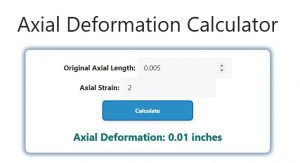About Axial Deformation Calculator (Formula)
Axial deformation is a critical concept in mechanics and materials science, referring to the change in length of a material when subjected to axial loads. This phenomenon is essential for engineers and designers who need to understand how materials will respond under stress. The Axial Deformation Calculator helps users quickly determine the deformation in a material by using the strain and original length. Understanding this calculation is vital for ensuring the integrity and safety of structures and components in various applications, from construction to manufacturing.
Formula
The formula for calculating axial deformation (AD) is:
AD = ε * L
In this formula:
- AD represents axial deformation.
- ε stands for strain (the change in length per unit length).
- L signifies the original length of the material.
How to Use
Using the Axial Deformation Calculator is straightforward. Here’s how to use it effectively:
- Determine the Strain (ε): Measure the strain in the material, which is a dimensionless quantity representing the deformation per unit length.
- Measure the Original Length (L): Determine the original length of the material before deformation occurs.
- Input Values: Enter the values for strain and original length into the calculator.
- Calculate: The calculator will compute the axial deformation based on the provided inputs.
Example
Let’s go through an example to illustrate how to use the Axial Deformation Calculator:
Suppose you have the following measurements:
- Strain (ε) = 0.005 (this means the material stretches by 0.5%)
- Original Length (L) = 2 m
Using the Formula:
Now plug in the values:
AD = ε * L
AD = 0.005 * 2
AD = 0.01 m
Thus, the axial deformation is 0.01 m, indicating that the material has elongated by 10 mm.

FAQs
- What is axial deformation?
Axial deformation is the change in length of a material when subjected to axial forces. - What is strain in the context of axial deformation?
Strain is the ratio of change in length to the original length, indicating how much a material deforms. - How does axial deformation differ from lateral deformation?
Axial deformation occurs along the length of the material, while lateral deformation occurs perpendicular to the axial direction. - Why is calculating axial deformation important?
It helps engineers design structures and components that can withstand applied loads without failure. - What factors affect axial deformation?
Factors include material properties (like elasticity), the magnitude of the load, and the geometry of the material. - Can axial deformation be negative?
Yes, a negative value indicates contraction rather than elongation of the material. - What materials are typically analyzed for axial deformation?
Common materials include metals, polymers, and composites used in construction and manufacturing. - What is Young’s modulus, and how is it related to axial deformation?
Young’s modulus measures the stiffness of a material and relates stress to strain; it helps predict how much deformation will occur under a given load. - Can axial deformation lead to failure?
Yes, excessive axial deformation can lead to material failure or structural collapse. - Is there a limit to how much a material can deform?
Yes, materials have elastic limits beyond which they will deform plastically or break. - How often should axial deformation be calculated in engineering projects?
It should be calculated during the design phase and regularly assessed during the service life of structures. - Are there specific tools for measuring strain?
Yes, strain gauges and extensometers are commonly used to measure strain in materials. - How does temperature affect axial deformation?
Temperature changes can cause thermal expansion or contraction, affecting the overall length of materials. - What are some common applications for the axial deformation calculator?
It is used in structural engineering, mechanical design, and materials testing. - Can this calculator be used for dynamic loading conditions?
While it is primarily designed for static loading, it can provide insights into dynamic conditions with appropriate modifications. - What is the difference between elastic and plastic deformation?
Elastic deformation is reversible, while plastic deformation is permanent and occurs after the yield point of a material. - How do you ensure accuracy when measuring original length?
Use precise measuring tools and techniques to minimize errors in length measurements. - What role does geometry play in axial deformation?
The geometry of the material can influence how loads are distributed, affecting the extent of deformation. - Can axial deformation be calculated for non-homogeneous materials?
Yes, but it requires more complex analysis to account for variations in material properties. - What should I do if the calculated deformation exceeds safety limits?
Reassess the design, consider using stronger materials, or implement additional supports to manage the load.
Conclusion
The Axial Deformation Calculator is an essential tool for engineers and designers working with materials subjected to axial loads. By accurately calculating axial deformation, users can ensure the safety and integrity of structures and components, leading to more effective designs and better material management. Regular use of this calculator can help prevent failures and enhance the performance of engineering applications, making it a vital resource in materials science and engineering.